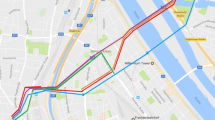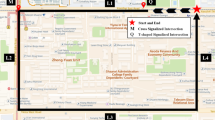Abstract
Vehicles tend to produce more pollutants especially particles at an urban intersection than other segments. Meanwhile, pedestrians at an intersection are inevitably exposed to high particle level and suffered from the health problem. Especially, some particles can deposit in different thoracic areas of the respiratory system and cause serious health problems. Hence, in this paper, the particles from 0.3 to 10 μm in 16 channels were measured to compare the spatio-temporal characteristics of them on the crosswalk and the roadside. Based on the roadside of fixed measurements, submicron particles (< 1 μm) are discovered to have a high relation with traffic signal and exhibit a bimodal distribution pattern in the green phase. On the crosswalk of mobile measurements, submicron particles present decreasing trend along the crosswalk while crossing. Additionally, mobile measurements were conducted across six time intervals that correspond to different pedestrian’s journey when passing the crosswalk. The results showed that all size particles in the first three journeys present high concentrations than that in other journeys. Furthermore, pedestrian exposure to all 16 channel particles was assessed. The total and regional deposition fractions of these particles in different sizes and age groups are determined. What ought to be paid attention to is that these real-world measurement results contribute to advancing the understanding of pedestrian exposure to size-fractionated particles on crosswalk and assisting the pedestrian to make better informed choice so as to limit particle exposure in these pollution hotspots.
Graphical abstract









Similar content being viewed by others
Data availability
All data generated or analyzed during this study are included in this published article.
References
Anderson JO, Thundiyil JG, Stolbach A (2012) Clearing the air: a review of the effects of particulate matter air pollution on human health. J Med Toxicol 8:166–175
Asbach C, Fissan H, Stahlmecke B, Kuhlbusch TAJ, Pui DYH (2009) Conceptual limitations and extensions of lung-deposited Nanoparticle Surface Area Monitor (NSAM). J Nanopart Res 11:101–109
Brook RD, Rajagopalan S, Pope CA, Brook JR, Bhatnagar A, Diez-Roux AV, Holguin F, Hong YL, Luepker RV, Mittleman MA, Peters A, Siscovick D, Smith SC, Whitsel L, Kaufman JD, Epidemiol AHAC, Dis CKC, Metab CNPA (2010) Particulate matter air pollution and cardiovascular disease an update to the scientific statement from the american heart association. Circulation 121:2331–2378
Buonanno G, Fuoco FC, Stabile L (2011) Influential parameters on particle exposure of pedestrians in urban microenvironments. Atmos Environ 45:1434–1443
Carpentieri M, Kumar P, Robins A (2012) Wind tunnel measurements for dispersion modelling of vehicle wakes. Atmos Environ 62:9–25
Cheng KH, Swift DL (1995) Calculation of total deposition fraction of ultrafine aerosols in human extrathoracic and intrathoracic regions. Aerosol Sci Technol 22:194–201
Elihn K, Berg P, Liden G (2011) Correlation between airborne particle concentrations in seven industrial plants and estimated respiratory tract deposition by number, mass and elemental composition. Aerosol Sci Technol 42:127–141
Gokhale S, Raokhande N (2008) Performance evaluation of air quality models for predicting PM10 and PM2.5 concentrations at urban traffic intersection during winter period. Sci Total Environ 394:9–24
He HD, Gao H (2020) Particulate matter exposure at a densely populated urban traffic intersection and crosswalk. Environ Pollut
He HD, Lu WZ (2012) Urban aerosol particulates on Hong Kong roadsides: size distribution and concentration levels with time. Stoch Env Res Risk A 26:177–187
Hinds WC (1999) Aerosol technology: properties, behavior, and measurement of airborne particles. Elsevier Ltd
HKTD (2020) The Annual Traffic Census 2019. Available at. https://www.td.gov.hk/filemanager/en/content_5018/annual%20traffic%20census%202019.pdf
ICRP (1994) Human respiratory tract model for radiological protection. A report of a task group of the international commission on radiological protection. Ann ICRP 24:1
Ishaque MM, Noland RB (2008) Simulated pedestrian travel and exposure to vehicle emissions. Transp Res D Transp Environ 13:27–46
John W, Wall SM, Ondo JL, Winklmayr W (1990) Modes in the size distributions of atmospheric inorganic aerosol. Atmos Environ Part A. General Topics 24:2349–2359
Kan H, Chen B (2004) Particulate air pollution in urban areas of Shanghai, China: health-based economic assessment. Sci Total Environ 322:71–79
Khan JZ, Sun L, Tian Y, Shi G, Feng Y (2021) Chemical characterization and source apportionment of PM1 and PM2.5 in Tianjin, China: impacts of biomass burning and primary biogenic sources. J Environ Sci 99:196–209
Knoblauch RL, Pietrucha MT, Nitzburg M (1996) Field studies of pedestrian walking speed and start-up time. Transp Res Rec 1538:27–38
Kumar P, Goel A (2016) Concentration dynamics of coarse and fine particulate matter at and around signalised traffic intersections. Environ Sci Process Impacts 18:1220–1235
Kumar P, Hama S, Nogueira T, Abbass RA, Brand VS, Andrade MD, Asfaw A, Aziz KH, Cao SJ, El-Gendy A, Islam S, Jeba F, Khare M, Mamuya SH, Martinez J, Meng MR, Morawska L, Muula AS, Nagendra SMS et al (2021) In-car particulate matter exposure across ten global cities. Sci Total Environ 750
Li H, Dai QY, Yang M, Li F, Liu X, Zhou M, Qian X (2020) Heavy metals in submicronic particulate matter (PM1) from a Chinese metropolitan city predicted by machine learning models. Chemosphere 261:127571
Lv HT, Li HJ, Qiu ZW, Zhang F, Song JH (2021) Assessment of pedestrian exposure and deposition of PM10, PM2.5 and ultrafine particles at an urban roadside: a case study of Xi'an, China. Atmos Pollut Res 12:112–121
Lyu X, Guo H, Simpson IJ, Meinardi S, Louie PKK, Ling Z, Wang Y, Liu M, Luk CWY, Wang N, Blake DR (2016) Effectiveness of replacing catalytic converters in LPG-fueled vehicles in Hong Kong. Atmos Pollut Res 16:6609–6626
Morici G, Cibella F, Cogo A, Palange P, Bonsignore MR (2020) Respiratory effects of exposure to traffic-related air pollutants during exercise. Frontiers. Public Health 8
Pan W, Chen XL, Duan XJ, Xue Y, Jia LS (2022) Particulate matter exposure at urban traffic intersection during haze episodes: a case study in Changsha. Sci Total Environ 838
Qiao T, Xiu G, Zheng Y, Yang J, Wang L (2015) Characterization of PM and microclimate in a Shanghai subway tunnel, China. Procedia Eng 102:1226–1232
Qiu ZW, Xu XQ, Song JH, Luo YP, Zhao RN, Xiang BH, Zhou WC, Li XX, Hao YZ (2017) Pedestrian exposure to traffic PM on different types of urban roads: a case study of Xi'an, China. Sustain Cities Soc 32:475–485
Sanchez-Soberon F, Mari M, Kumar V, Rovira J, Nadal M, Schuhmacher M (2015) An approach to assess the particulate matter exposure for the population living around a cement plant: modelling indoor air and particle deposition in the respiratory tract. Environ Res 143:10–18
Scungio M, Stabile L, Rizza V, Pacitto A, Russi A, Buonanno G (2018) Lung cancer risk assessment due to traffic-generated particles exposure in urban street canyons: a numerical modelling approach. Sci Total Environ 631-632:1109–1116
Song JH, Qiu ZW, Ren G, Li XX (2020) Prediction of pedestrian exposure to traffic particulate matters (PMs) at urban signalized intersection. Sustain Cities Soc 60
Tiwary A, Robins A, Namdeo A, Bell M (2011) Air flow and concentration fields at urban road intersections for improved understanding of personal exposure. Environ Int 37:1005–1018
Vu VT (2016) Physical properties and lung deposition of particles emitted from five major indoor sources. Air Qual Atmos Health 10:1–14
Wang WJ (2020) Everyday practice in the high density, volumetric Hong Kong: ambiguity, intensity and life between interfaces. Cities 96
Wang Z, Zhong S, He H-D, Peng Z-R, Cai M (2018) Fine-scale variations in PM2.5 and black carbon concentrations and corresponding influential factors at an urban road intersection. Build Environ 141:215–225
Wang ZY, He HD, Zhao HM, Peng ZR (2021) Spatiotemporal analysis of pedestrian exposure to submicron and coarse particulate matter on crosswalk at urban intersection. Build Environ 204
Wang ZY, Lu QC, He HD, Wang DS, Gao Y, Peng ZR (2017) Investigation of the spatiotemporal variation and influencing factors on fine particulate matter and carbon monoxide concentrations near a road intersection. Front Earth Sci 11:63–75
Weber S, Kordowski K, Kuttler W (2013) Variability of particle number concentration and particle size dynamics in an urban street canyon under different meteorological conditions. Sci Total Environ 449:102–114
Zhu XH, He HD, Lu KF, Peng ZR, Gao HO (2022) Characterizing carbon emissions from China V and China VI gasoline vehicles based on portable emission measurement systems. J Clean Prod 378:134458
Funding
This study was partially funded by the National Natural Science Foundation of China (nos. 12072195 and 11902083).
Author information
Authors and Affiliations
Contributions
Data collection and analysis: Hong-di He, Zi-ye Wang, and Hong-mei Zhao; interpretation of results: Zi-ye Wang, Hong-di He, and Hong-mei Zhao; draft manuscript preparation: Zi-ye Wang, Wei Pan, and Wei-zhen Lu. All authors reviewed the results and approved the final version of the manuscript.
Corresponding author
Ethics declarations
Ethical approval
Not applicable.
Consent to participate
Not applicable.
Consent for publication
Not applicable.
Competing interests
The authors declare no competing interests.
Additional information
Responsible Editor: Lotfi Aleya
Publisher’s note
Springer Nature remains neutral with regard to jurisdictional claims in published maps and institutional affiliations.
Highlights
• Particles within 0.3–10 μm in 16 channels were investigated on crosswalk of intersection.
• Particles less than 2 μm present evidently linear variations along the crosswalk.
• The smaller particles show more obvious periodic variations on roadside of intersection.
• Adults tend to have more deposition in head airways region in contrast to others.
Supplementary information
Rights and permissions
Springer Nature or its licensor (e.g. a society or other partner) holds exclusive rights to this article under a publishing agreement with the author(s) or other rightsholder(s); author self-archiving of the accepted manuscript version of this article is solely governed by the terms of such publishing agreement and applicable law.
About this article
Cite this article
He, Hd., Wang, Zy., Zhao, Hm. et al. Spatial-temporal distribution and pedestrian exposure assessment of size-fractionated particles on crosswalk of urban intersection. Environ Sci Pollut Res 30, 83917–83928 (2023). https://doi.org/10.1007/s11356-023-28150-3
Received:
Accepted:
Published:
Issue Date:
DOI: https://doi.org/10.1007/s11356-023-28150-3




